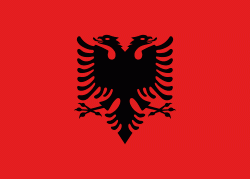Ura Vajgurore (Bashkia Ura Vajgurore)
Ura Vajgurore, formerly known as Ura e Hasan Beut, is a town and a former municipality in Berat County, central Albania. At the 2015 local government reform it was merged with the former municipalities (now municipal units) Cukalat, Kutalli and Poshnjë to form a new municipality, that was officially renamed to Dimal in April 2021. The seat of the municipality Dimal is the town Ura Vajgurore, that was not renamed in 2021. The population at the 2011 census was 7,232.
Ruins in the style of the old Gorica bridge in Berat attest to the existence of early inhabitants and what would later become the town today. The contemporary city has its origins in recent displacements of residents from nearby villages over the last 100 years. The building of bridges has been the mark of continuity in the town's history. Known by various names, such as Bridge of Hasan Bey, the contemporary name comes from a cement and iron bridge believed to have been built by the Italians as infrastructure for oil pipelines that connected Kuçovë with Vlorë. Local residents call it the "Old Bridge." Today it is a small town, known as a crossroad between Berat and Kuçovë.
Ura Vajgurore was the scene of violent riots in 1997 between supporters of the political parties PS and PD, in the context of the Albanian Civil War that was ignited by failing pyramid schemes. Four police officers were killed and six others were injured.
Ruins in the style of the old Gorica bridge in Berat attest to the existence of early inhabitants and what would later become the town today. The contemporary city has its origins in recent displacements of residents from nearby villages over the last 100 years. The building of bridges has been the mark of continuity in the town's history. Known by various names, such as Bridge of Hasan Bey, the contemporary name comes from a cement and iron bridge believed to have been built by the Italians as infrastructure for oil pipelines that connected Kuçovë with Vlorë. Local residents call it the "Old Bridge." Today it is a small town, known as a crossroad between Berat and Kuçovë.
Ura Vajgurore was the scene of violent riots in 1997 between supporters of the political parties PS and PD, in the context of the Albanian Civil War that was ignited by failing pyramid schemes. Four police officers were killed and six others were injured.
Map - Ura Vajgurore (Bashkia Ura Vajgurore)
Map
Country - Albania
 |
 |
| Flag of Albania | |
Albania has been inhabited by different civilisations over time, such as the Illyrians, Thracians, Ancient Greeks, Romans, Byzantines, Venetians, and Ottomans. The Albanians established the autonomous Principality of Arbër in the 12th century. The Kingdom of Albania and Principality of Albania formed between the 13th and 14th centuries. Prior to the Ottoman conquest of Albania in the 15th century, the Albanian resistance to Ottoman expansion into Europe led by Skanderbeg won them acclaim over most of Europe. Albania remained under Ottoman rule for nearly five centuries, during which many Albanians (known as Arnauts) attained high-ranking offices in the empire, especially in the Southern Balkans and Egypt. Between the 18th and 19th centuries, cultural developments, widely attributed to Albanians having gathered both spiritual and intellectual strength, conclusively led to the Albanian Renaissance. After the defeat of the Ottomans in the Balkan Wars, the modern nation state of Albania declared independence in 1912. In the 20th century, the Kingdom of Albania was invaded by Italy, which formed Greater Albania before becoming a protectorate of Nazi Germany. Enver Hoxha formed the People's Socialist Republic of Albania after World War II, modeled under the terms of Hoxhaism. The Revolutions of 1991 concluded the fall of communism in Albania and eventually the establishment of the current Republic of Albania.
Currency / Language
| ISO | Currency | Symbol | Significant figures |
|---|---|---|---|
| ALL | Albanian lek | L | 2 |
| ISO | Language |
|---|---|
| SQ | Albanian language |
| EL | Greek language |















